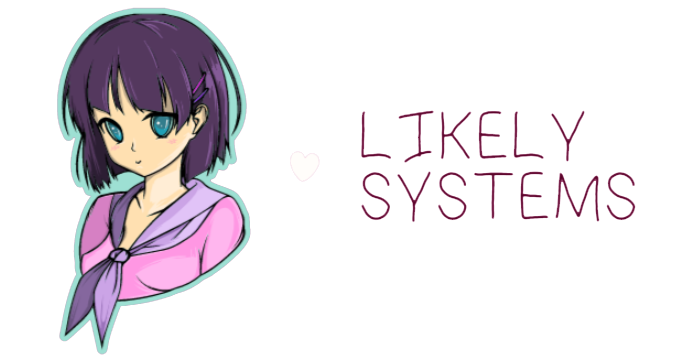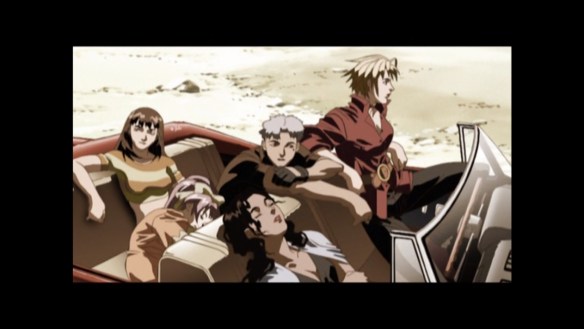Hello folks, and welcome back to Wrong Every Time. Today we’re stepping back into Sol Bianca: The Legacy, a six-episode OVA from the tail end of the twentieth century, and the sequel to a never-concluded predecessor from the early ‘90s. Anime’s direct-to-video era is littered with such artifacts, series that were cut short either by disappointing sales or staff exodus, leaving only fragmentary segments of ambitious, beautifully realized fantasy in their wake. Works were smaller in scale yet greater in implication; in an era largely given over to franchise replication, a landscape dominated by such lingering absences feels strangely alluring.
Anyway, context aside, Sol Bianca’s first episode introduced us to the titular ship and its crew of apparent bounty hunters, on the hunt for a pistol scavenged from the ruins of Earth. Along the way, they ran afoul of the ambiguous Terra Force, and ultimately picked up a young girl named Mayo with a mysterious past, who claims her parents await on the long-lost ruins of Earth itself. Thus the stage is set for a grand pilgrimage, one overtly framed in the context of Abraham’s journey to Canaan. Whatever awaits, I’m looking forward to more of this production’s sumptuous art design. Let’s get to it!
Episode 2
We open with our crew chilling in a convertible on a balmy desert day, in a letterboxed format that only amplifies the sense we’re at the beginning of a cool-ass music video. Sol Bianca’s first episode demonstrated a variety of priorities, and one of them is clearly “letting our protagonists look cool as hell in various environments and outfits”
Oh man, using the turn of the ignition as the beginning of your title sequence. Style for days here, with very purposeful blocking and an emphasis on incidental, character-defining body language
They appear to be exploring an ancient ruin of some kind, perhaps Mayan in nature. Getting an interesting mix of variables here, between the calls to Christian mythology, variable earth artifacts, and the Spanish UI of the Sol Bianca itself
Powerful sense of visual continuity across these cuts – action transfers from one to the next in clever, graceful ways, like this leap being reflected in another character’s shades
The OP song also feels extremely of its era, like something from .hack or Lain
On the other hand, I cannot in good conscious support their use of the papyrus font
The OP ends on a charged image – our captain April finding an egg on the beach, which begins to crack in her hand
A fresh epigraph for our second episode: “All hope abandon ye who enter here! And when his hand he had stretch’d forth to mine, with pleasant looks when I was cheer’d, into the secret place he led me on.” From Dante’s Divine Comedy, describing the protagonist’s meeting with Virgil and entrance into hell. Introducing some ambiguity then, as to whether Mayo is leading our party to damnation or the promised land. What truly remains of this place called Earth?
“La Reminiscencia.” Continuing with the use of Spanish text, which seems to frame our leads as either cowboys or conquistadors
April shows a sun tarot card to an informant, who warns her she’s better off staying away from their current destination
“No one has made it out of those ruins alive except for me.”
“A certain man’s horrible curse haunts that area”
The character designs for this show are so distinctive! Very prominent bone structures, little “softness” to them, with an emphasis on how shadows would fall across strong, pronounced features. The Yasuomi Umetsu vibes are strong, but even Umetsu generally makes greater concessions to rounded, standard anime beauty standards, rather than these craggy, somewhat more masculine features
With only six episodes total, no time is wasted on connective tissue; we’re dropped immediately into their next adventure, Mayo now an assumed member of the crew
They pierce through heavy atmosphere and out above an abandoned frontier-era city
A classic image: a clocktower broken and leaning, emphasizing how time has stopped for this world
The smooth lines of their CG ship integrate well with the background, assisted by their complimentary grey tones
In the center of the city we find our egg, a massive egg-shaped building marked “MEGASEED.” So presumably a vault of some kind, perhaps a seed for a renewed Earth, potentially containing all the biological samples and data needed to birth a new home for humanity
The door to this egg is marked with statues of humans in agony, as if this were the seal of Pandora’s Box
Our tech expert Jun debuts her holographic assistant to open the door, named “Sancho” after Sancho Panza, Don Quixote’s eternally put-upon follower. A name that cheekily implies our heroes are on an inherently doomed, pointless quest
Mayo briefly sees a golden-haired woman within the door. I wonder what the origin texts are for this conceit of the “star child,” the innocent who has mysterious powers and visions of the hidden truth? I suppose much of it might just be the secularization of religious narratives – rather than a priest or monk, the figure of destiny is transformed into a child representing humanity’s hopeful future
This is the genius of Dragon Ball, of course – rather than transforming Journey to the West’s monk into an innocent child, Toriyama transformed him into Bulma, who opens fire on Goku the moment she meets him
Jun and Mayo stumble through the door before it’s sealed
Meanwhile, the old man April consulted with appears to have been conscripted by Terra Force, who are chasing April to the planet of Consegra
Sancho is a fine addition. The animators are clearly having fun with his more exaggeration-friendly features, embracing the cartoonish expression work that this production’s otherwise highly detailed facial structures precludes. Realistic, detailed faces have their strengths and weaknesses, and one of the main things you’re abandoning is cartoonish elasticity
A phantom appears before the trio and declares it will curse them. Sol Bianca’s realistic designs work wonderfully for this character – leaning into the pronounced facial shading, this ghost’s features are etched in darkness
“The Divine Comedy is a story which Dante created based on his life of disappointment.” Harsh but fair. A significant portion of Inferno is dedicated to Dante describing the infernal punishments awaiting various people he disliked at court
They arrive at a spectral river, mirroring the Acheron’s role in Greek mythology (the role that Romans would assign to the river Styx)
“They sure are spoiled… a gondola just for the dead?” Jun has a charmingly obnoxious personality
Then a massive blade almost lops off their heads. Always gotta be ready for Indiana Jones traps
Ooh, nice pan out of depth as they reach some kind of crystal hall. Efficient work here – the scale of the room is large enough that perspective doesn’t shift, meaning just adding a few cel layers with individual foreground characters creates a convincing illusion of camera movement
The hall is guarded by three lasers, echoing the three heads of Cerberus. Jun is not impressed
Terra Force arrive, with their fighter jets swiftly running into a drunken Sol Bianca-piloting Feb
The core of this facility appears to hold records of the twentieth century and mankind’s eventual flight into space, ending in a promise by an unknown man to our golden-haired “Flor,” stating that his terraforming operations would end humanity’s energy crisis
Flor’s memories were transferred to this computer. I love the sort of “makeup” work they’re doing with her face, using incredibly delicate shading for her lips and eyelashes to create a sort of “hyper-real” intensity in her appearance. It sorta reminds me of Studio Wit’s makeup unit, who embellished high-impact shots for shows like Kabaneri and After the Rain
The man who did all this is named Void, presumably the figure who cursed them initially
Jun hacks her way to the core while the other Sol Bianca crew dogfight with Terra Force, adding some genuine visual drama to her furious typing
Our spectacled scion of Terra Force decides it’s time to destroy the MegaSeed
Jun reaches the two coffins at the center of the MegaSeed, representing both Void’s end and Dante’s ascension into heaven
Flor tells us the story of Void, how he came here to terraform the planet, how he was abandoned by his fellow scientists and ultimately turned to liquor. It was Flor’s suicide that prompted his current incarnation, a curse of broken dreams that has carried on through the centuries
Flor pleads with Jun to end his program, and she reluctantly agrees
I’m really fascinated by all the inherent gaps in this story; there’s so much we don’t know about Sol Bianca’s crew, more than it feels like two preceding OVAs could possibly cover. The sense of narrative compression and missing threads endemic to the OVA era feels uniquely alluring, like we were only able to extract fragmentary relics from much larger narratives, a sensation that makes these stories and worlds feel much larger than their actual running time. I’m reminded of the natural filling-in I was forced to do as a child, when I could only catch staggered episodes of something like Outlaw Star, and thus had to fill in the gaps with my own imagination. That in particular was a product of my viewing pattern, but these OVAs seem to intentionally cultivate such an effect
Jun says she “hates old-fashioned women like you,” seemingly disgusted by Flor’s reliance on Void’s love. More mysteries of identity that we may never resolve
Some excellent layouts as the egg begins to collapse; love this low-angle, super-foreshortened cut as Jun rushes towards the exit, which makes it feel as if she’s pushing off the camera itself to run forward
The egg begins a chain reaction, and the entire planet is consumed by explosions. Void’s legacy destroyed
Ah, I see – April found Jun aboard the Sol Bianca itself, an android who had been left alone for centuries. Thus Jun saw herself in Flor, and hated the resemblance, abandoning her even though she could have actually saved her. The loneliness of eternity breeds dependence; Jun knew exactly why Flor couldn’t leave Void
And Done
Thus our heroes journey onwards into the vast unknown, having retrieved nothing from the planet Consegra except the memory of a lost love, and a reminder that we can make heaven or hell wherever we stand. A solid episode on the whole, honing in on Jun and Mayo in order to tell a compelling personal drama with a stinger that genuinely recontextualized everything we’d seen before. I tend to not be a fan of “characterization through hidden information” as a rule, as I’d rather relate to a character’s humanity in the moment than only understand them long after the fact, but this drama was concise enough to make effective use of the concept, by essentially characterizing Jun through her reaction to each new revelation about Flor. That plus Sancho’s expressiveness, the action theatrics of her friends, and the array of nefarious temple traps all combined for a generous episode that still maintained Sol Bianca’s ethereal, dreamlike tone. Onward to the stars!
This article was made possible by reader support. Thank you all for all that you do.




